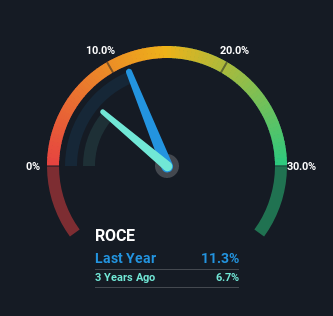If you're not sure where to start when looking for the next multi-bagger, there are a few key trends you should keep an eye out for. In a perfect world, we'd like to see a company investing more capital into its business and ideally the returns earned from that capital are also increasing. This shows us that it's a compounding machine, able to continually reinvest its earnings back into the business and generate higher returns. However, after briefly looking over the numbers, we don't think HBL Power Systems (NSE:HBLPOWER) has the makings of a multi-bagger going forward, but let's have a look at why that may be.
What is Return On Capital Employed (ROCE)?
If you haven't worked with ROCE before, it measures the 'return' (pre-tax profit) a company generates from capital employed in its business. The formula for this calculation on HBL Power Systems is:
Return on Capital Employed = Earnings Before Interest and Tax (EBIT) ÷ (Total Assets - Current Liabilities)
0.11 = ₹1.0b ÷ (₹11b - ₹2.2b) (Based on the trailing twelve months to March 2022).
Therefore, HBL Power Systems has an ROCE of 11%. In absolute terms, that's a pretty normal return, and it's somewhat close to the Electrical industry average of 12%.
Check out our latest analysis for HBL Power Systems

Historical performance is a great place to start when researching a stock so above you can see the gauge for HBL Power Systems' ROCE against it's prior returns. If you'd like to look at how HBL Power Systems has performed in the past in other metrics, you can view this free graph of past earnings, revenue and cash flow.
What The Trend Of ROCE Can Tell Us
Over the past five years, HBL Power Systems' ROCE and capital employed have both remained mostly flat. Businesses with these traits tend to be mature and steady operations because they're past the growth phase. So don't be surprised if HBL Power Systems doesn't end up being a multi-bagger in a few years time.
One more thing to note, even though ROCE has remained relatively flat over the last five years, the reduction in current liabilities to 19% of total assets, is good to see from a business owner's perspective. This can eliminate some of the risks inherent in the operations because the business has less outstanding obligations to their suppliers and or short-term creditors than they did previously.
In Conclusion...
In summary, HBL Power Systems isn't compounding its earnings but is generating stable returns on the same amount of capital employed. Yet to long term shareholders the stock has gifted them an incredible 131% return in the last five years, so the market appears to be rosy about its future. Ultimately, if the underlying trends persist, we wouldn't hold our breath on it being a multi-bagger going forward.
On a separate note, we've found 2 warning signs for HBL Power Systems you'll probably want to know about.
While HBL Power Systems isn't earning the highest return, check out this free list of companies that are earning high returns on equity with solid balance sheets.
Valuation is complex, but we're here to simplify it.
Discover if HBL Engineering might be undervalued or overvalued with our detailed analysis, featuring fair value estimates, potential risks, dividends, insider trades, and its financial condition.
Access Free AnalysisHave feedback on this article? Concerned about the content? Get in touch with us directly. Alternatively, email editorial-team (at) simplywallst.com.
This article by Simply Wall St is general in nature. We provide commentary based on historical data and analyst forecasts only using an unbiased methodology and our articles are not intended to be financial advice. It does not constitute a recommendation to buy or sell any stock, and does not take account of your objectives, or your financial situation. We aim to bring you long-term focused analysis driven by fundamental data. Note that our analysis may not factor in the latest price-sensitive company announcements or qualitative material. Simply Wall St has no position in any stocks mentioned.
About NSEI:HBLENGINE
HBL Engineering
Manufactures and sells batteries and other products in India and internationally.
Flawless balance sheet with solid track record.
Market Insights
Community Narratives



